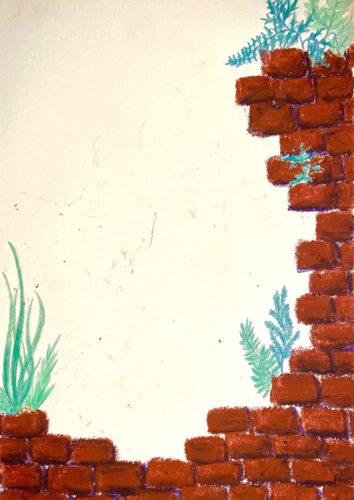Art Courtesy of Miranda Selin.
Imagine walking down an old pathway, strewn with weathered stones, when you trip on a loose brick. You might be irritated, but what if those mundane little bricks were more than an annoyance? What if they hid the secrets of civilizations from thousands of years ago?
During a series of excavations beginning in 1949 led by Max Mallowan and other British archeologists, a clay brick was excavated from the ancient city of Kalhu in Mesopotamia, today known as Nimrud, Iraq. The brick dates back 2,900 years to 879 B.C., which was during the reign of King Ashurnasirpal II over the Neo-Assyrian Empire from 883 B.C. to 859 B.C. The Neo-Assyrian empire was remarkable for many reasons, including advancements in astronomy and mathematics, as well as impressive architecture. The excavated “brick of life” was once part of King Ashrunasipal’s palace. It is a sundried concoction of straw, animal dung, and mud from the Tigris River, with an Akkadian inscription on it that reads: “the property of the palace of Ashurnasirpal, king of Assyria.”
The unassuming brick, which had broken horizontally into two pieces, was then donated to the National Museum of Denmark in 1958. Later, a group of scientists digitized it, splitting the brick again, but this time vertically. However, this split wasn’t troublesome—in fact, it was quite the opposite, as it allowed researchers to study uncontaminated material inside the brick. In an interview with Troels Pank Arbøll, Assistant Professor of Assyriology at the University of Copenhagen and a key figure in the project, he conveyed optimism and enthusiasm for the potential discoveries on the horizon. The brick is a portal to a bygone era that invites us to peer into the archives of history.
The researchers took five separate samples from the cracks in the clay and analyzed them to produce the aDNA—ancient DNA—of thirty-four taxonomic groups of plants. Each crack offered a look into the past. This was done through two cutting-edge sequencing techniques—a process in molecular biology that involves determining the precise order of the building blocks of DNA molecules. The first technique is amplicon sequencing, which selectively amplifies and sequences specific DNA regions within a larger genetic sample. The second is metagenomic shotgun sequencing, which enables the exploration of all genes across all organisms within a complex sample. These precise and critical sequencing techniques were vital tools in uncovering the truths behind the fragile aDNA, which is highly degraded due to its age. The pursuit of these invaluable insights demanded patience and unwavering commitment.
Scientists are certain that the DNA is uncontaminated since all of the samples came from the core of the brick, which has not been exposed to the outside world since the brick was first created roughly 2900 years ago. Such certainty is remarkable, as it is rare for aDNA so old to remain untouched. The species found in the clay brick include specimens correlated with different types of Iraqi flora, carrots, parsnips, celery, birch, and more. This aDNA has bridged gaps in our understanding of the Neo-Assyrian Empire, serving as a portal into the past.
The brick’s aDNA can also help us to look into the future. By studying the species in such bricks, researchers may notice differences and similarities between plants from 2900 years ago and today. These observations will be important to combat climate change and help our ecosystem because the past furnishes researchers with invaluable insights into patterns of biodiversity loss, teaching us how to mitigate similar perils in the present day. “The goal would be, in due time, to establish a dataset of historical biodiversity for reference in current discussions,” Abrøll said. Examining how ecosystems responded and adapted in the past can shed light on their resilience and capacity for recovery in the future.
Beyond advancing our understanding of the ecosystem and our history, this discovery shows the necessity of interdisciplinary collaboration. When discussing the possible future for research around endemic plants in Iraq, Arbøll emphasizes the importance of collaborating with scientists when researching the history of these plants. “It is our hope that future studies with more concrete identifications of ancient DNA might help speed this process up,” Arbøll said.
So, the next time you encounter a tricky loose brick, consider the possibility that it might harbor a treasure trove of secrets, bridging the chasm between antiquity and modernity—a testament to the unyielding wonders concealed within the world’s most unassuming corners.

